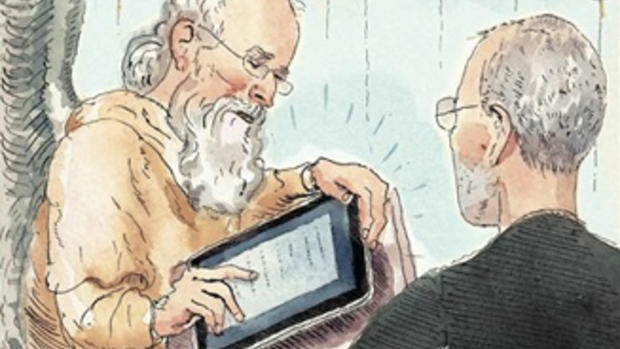New Yorker covers: Ironic, iconic, unforgettable
(CBS News) We've UNCOVERED some artifacts from our recent past: The covers we MIGHT have seen on The New Yorker, if not for some eye-catching competition. Mo Rocca has been sorting through the archive:
You can't judge a book - or a magazine - by its cover. But you can certainly judge the covers themselves.
And for decades after its February 1925 debut issue, The New Yorker Magazine's covers projected a sophistication befitting its literary pedigree.
Amusing, ironic, sometimes iconic - like Saul Steinberg's view of the world from New York City. Many are bucolic, an escape from the worries of the world.
Then, in 1993 Francoise Mouly became art editor. Under her, the magazine's covers are more often political and provocative, like a cover about the military's "Don't Ask, Don't Tell" policy featuring two male sailors kissing in Times Square.
Mouly told Rocca that, when looking for a cover illustration, "We all want images that will be relevant, images that will make you laugh, images that will move you."
There were covers depicting Monica Lewinsky as Mona Lisa; Bill Clinton being questioned (from the waist down) about that affair with Lewinsky . . . and Sarah Palin's view of Russia from her house (an homage to the Steinberg cover).
And they're not only satirical images. There a commemoration of the inauguration of President Barack Obama, and the cover from the first issue after the 9/11 attacks with the only appropriate color combination: Black on black.
Mouly came from Paris to New York to study architecture, and married author and artist Art Spiegelman (who did the 9/11 cover and a provocative Valentine's Day cover). Together they published an avant garde comic book before she came to The New Yorker. She's overseen more than 950 New York covers.
From her office over Times Square, Mouly reviews cover submissions, and works with artists like Christoph Niemann: "I love working for The New Yorker because The New Yorker for illustrators really is like the Olympic Games of our discipline."
And every week is a competition.
After the killing of Osama bin Laden hundreds of ideas were submitted. Only one could be chosen.
"I asked them to send a rough sketch - don't think about it, and don't censor yourself," Mouly said. "And I need to see a range of emotions and range of reactions to event. And it's very useful to me."
The final choice: An image of bin Laden erased - rubbed out.
The approval process is simple: Just Mouly and David Remnick, the magazine's editor. The final decision on cover art rests with him.
"She only barges in, 'I have things I want to show you,'" he laughed.
One recent cover proposal was a take on the glories of air travel. After a brief consultation, changes were made. And the April 16th issue had its cover: "Carry On Luggage."
What defines a successful cover?
Sales? "No, absolutely not sales," said Remnick. "For us, it's what we like, what causes people to laugh or to talk about it or provoke discussion. That's the goal."
And how far do they want artists to go? "I want the artist to go in their sketches too far enough," Remnick said. "I want them to push the boundary to see where the boundary can be from week to week."
"You'd rather pull them back than have to push them?" said Rocca.
"Or at least have them provoke the discussion of how far is too far, and what we should be thinking about," Remnick replied. "Otherwise, it gets boring. Gets bland."
"Too far" may not make the magazine, but in many cases it made this book, "Blown Covers" - Mouly's collection of would-be New Yorker covers that were a bit little TOO daring.
Barry Blitt has drawn 70 covers for The New Yorker, more than any living artist. A lot of his submissions have not made it.
When asked if he feels like he is continuously auditioning, he replied, "I think when you stop feeling like you're auditioning, then it's a bad sign. When you've done a lot of these things, it hurts more when you hand in something and it looks like crap!"
One image that actually DID make the cover was 2008's notorious "Fist Bump" - with President Barack Obama as an "Islamic terrorist," Michelle Obama as a "Black Panther."
To Blitt and liberals, it's a satire of a right-winger's view of the future First Couple. But editor David Remnick received tons of complaints - from the LEFT.
"The biggest response, Mo, was 'I get it, but those people out there, the unwashed masses in those other flat states in the middle of the country, they couldn't possibly get it, and they will use it as an iconography - a literal-minded iconography that Obama is unpatriotic, etc., etc.,'" Remnick said.
"Is that a little bit condescending?" asked Rocca.
"I thought it was TOTALLY condescending!" Remnick replied.
Four years later, Barry Blitt still isn't sure the joke landed: "The fact is, it was so misunderstood, I can't say 'They're all crazy and I'm not.'"
But Mouly stands by "Fist Bump" - and every other cover in her nearly-20-year career at the magazine."You love your job, don't you?" Rocca asked.
"I think I have the best job in the world," she said.
And there's more wall space to be filled, with every week a creative puzzle to solve.
For more info:
- "Blown Covers: New Yorker Covers You Were Never Meant to See" by Francoise Mouly (Harry Abrams)
- blowncovers.com
- newyorker.com
- barryblitt.com
- rozchast.com
- Art Spiegelman (artcyclopedia.com)
- christophniemann.com
- Strand Book Store
